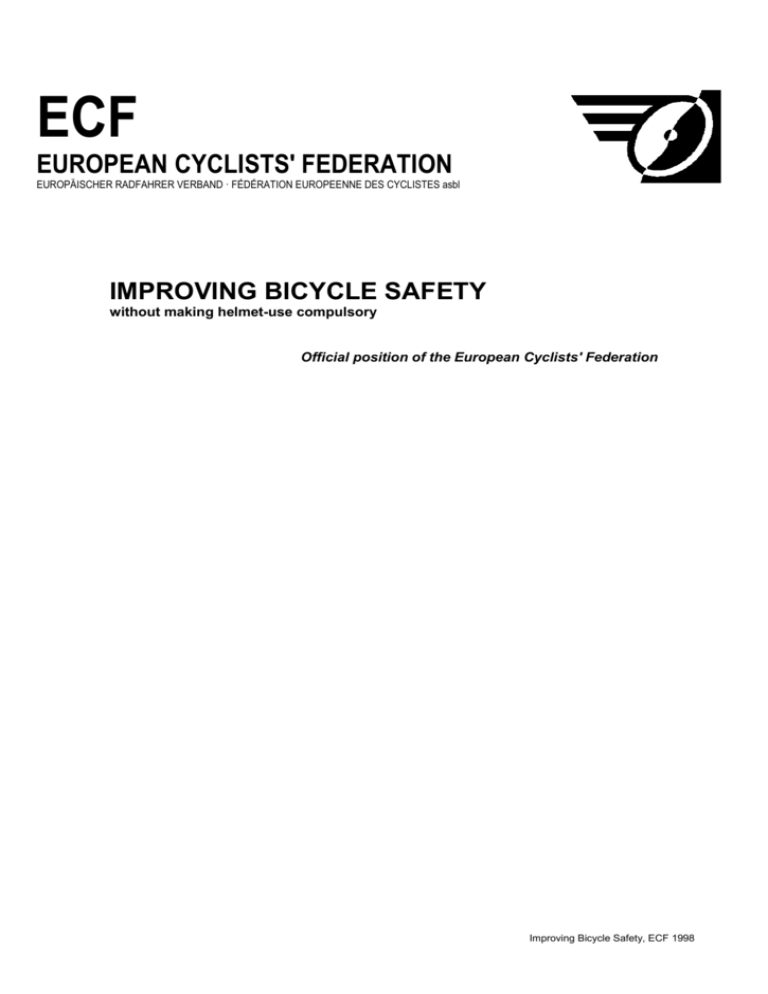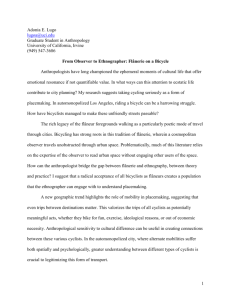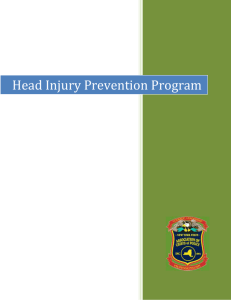IMPROVING BICYCLE SAFETY
advertisement

ECF EUROPEAN CYCLISTS' FEDERATION EUROPÄISCHER RADFAHRER VERBAND · FÉDÉRATION EUROPEENNE DES CYCLISTES asbl IMPROVING BICYCLE SAFETY without making helmet-use compulsory Official position of the European Cyclists' Federation Improving Bicycle Safety, ECF 1998 IMPROVING BICYCLE SAFETY without making helmet-use compulsory In this brochure we present proposals and methods which, in our opinion, are effective ways of improving road safety and the quality of life. CONTENTS 1. Safety and cycling promotion 2. Myths about cycle helmets 3. Why cycling is so important 3.1 Cycling prevents illness 3.2 Cycling without a helmet is healthier than not cycling at all 4. The consequences of compulsory helmet use 4.1 Compliance 4.2 Fewer cyclists 5. Why only for cyclists? 6. What doctors have to say about helmets 7. A new approach to road safety 8. Recommendations 9. Sources, bibliography and Internet addresses By Ulla Baden, Ernst Poulsen, Tom Godefrooij, Hildegard Resinger and Daniel Eritja. Editor: ECF asbl. Design and layout: Estudio Mariscal, Barcelona Printed by: Gràfiques Gispert, C/Pere IV 29-35, b. 1ª, Barcelona D/1998/8471/2 November 1998 © Reproduction is authorised provided the source is acknowledged. European Cyclists' Federation av. de Broqueville, 158, Box 3 B-1200 Brussels, Belgium Phone: +32 - 2 771 87 68 Fax: +32 - 2 762 30 03 E-mail: ecf_brussels@compuserve.com This publication has received financial support from Directorate-General XI (Environment) of the European Commission. Improving Bicycle Safety, ECF 1998 2 Page 3 5 8 8 9 10 10 11 12 13 14 15 16 1. SAFETY AND CYCLING PROMOTION There are many reasons for taking cycling seriously. Bicycles help preserve the environment and take up very little space in our crowded cities. They do not pollute or cause congestion. Cycling is a form of mobility within everybody's reach. And, what is more, cycling is healthy. For all these reasons, cycling should be promoted and transport policies should aim to get as many people as possible to cycle. The biggest obstacle to a real take-off in cycling is often the lack of road safety, so improved road safety must be a central theme of any policy to promote cycling. Politicians in some countries have recently considered introducing laws making it compulsory for cyclists to wear helmets. Although it is true that wearing a helmet can provide protection in some circumstances, making it compulsory would put many people off cycling altogether. Others would deliberately flout a law which they consider unreasonable and irrelevant. Worst of all, cycle helmets do not provide effective protection in collisions with cars, the main cause of death and serious injury to cyclists. Helmets can provide some protection to the head in the event of a collision, but they cannot prevent the accident from taking place. The European Cyclists' Federation believes that, instead of making it compulsory for cyclists to wear helmets, the authorities should concentrate on preventing accidents. Promoting the wearing of helmets by cyclists is not an effective way of improving safety for cyclists. Road safety for cyclists can only be improved by removing the danger at its source: by calming the traffic. 3 Improving Bicycle Safety, ECF 199 Improving Bicycle Safety, ECF 1998 4 2. MYTHS ABOUT CYCLE HELMETS During discussions of road safety for cyclists, a number of arguments are put forward in favour of obliging cyclists to wear helmets. While these arguments may appear convincing at first sight, when we take a closer look we find that they are not as conclusive as they may at first appear. STATEMENT: Bicycle helmets save lives. RESPONSE: While it is true that helmets can save lives, their potential should not be overestimated. An approved cycle helmet only resists impacts at speeds of up to 23 kph. A law making it compulsory for cyclists to wear helmets would reduce the number of cyclists. This, in turn, would lead to an increase in deaths from heart disease and other illnesses associated with a sedentary lifestyle (see section 3.1). The overall effect would be an increase in premature deaths. STATEMENT: The law obliging motorcyclists to wear helmets was also controversial when it was introduced, but time has shown it to be effective. The same would hold true for cyclists. RESPONSE: The protection offered by a motorcycle helmet cannot be compared to that offered by a bicycle helmet. A cyclist has to pedal hard to cycle up hills, and his/her head therefore needs to be well ventilated and could not support the weight of a full helmet without damaging the cyclist's health (see section 5). Motorcyclists travel at far higher speeds and an accident can be caused by a slight movement of the right hand, without any physical effort. The fact that bicycles and motorbikes have the same number of wheels is no reason for the same rules to apply to both. 5 Improving Bicycle Safety, ECF 199 STATEMENT: Racing cyclists and off-road cyclists are a high-risk group and must be protected. RESPONSE: Some cycle sports require protection like gumshields, kneepads or helmets, but an activity such as cycle racing bears no relation to riding a bike in traffic (see section 3.2). Almost all cycle sport federations have drawn up their own rules on this subject. The fact that some types of cycling involve a higher degree of risk does not justify making it compulsory for all cyclists to wear helmets at all times. STATEMENT: Promoting the wearing of helmets is a cost-effective way of reducing cyclist deaths. RESPONSE: Protective devices paid for by the individual are cheap for the authorities, but is the total amount of money spent cost-effective? Bicycle helmets are not effective in all cases, and collisions between fast-moving motor vehicles and cyclists will in any case be fatal (see section 6). Cycle helmets do not offer effective protection against most fatal road accidents. Improving Bicycle Safety, ECF 1998 6 STATEMENT: Helmets should at least be worn by children, who are more vulnerable than others. RESPONSE: The ECF maintains that road conditions should be adapted to the skills of vulnerable road users - children, elderly people and the disabled - and not the other way round. Nevertheless, there is some truth in this argument, as children have a lower perception of risk and are more often involved in 'single vehicle accidents', like falling off a bicycle. This is precisely the type of accident where a helmet designed for an 18 kph impact offers real protection. On the other hand, having to wear a helmet may put a child off cycling altogether (see section 4.2). For a bicycle promotion policy to be successful, it is essential not to discourage children from cycling. Should today's children stop cycling, the next generation may never take it up. Parents should be allowed to make an informed choice as to whether or not their child wears a helmet. STATEMENT: Campaigns to promote the voluntary wearing of helmets do not work, so helmets must be made compulsory. RESPONSE: This argument presupposes that helmets are the last word in road safety, but creating safer road conditions is far more effective. Helmet legislation may even distract attention from the need to improve the road environment, thus proving counterproductive to real road safety. A mandatory helmet law would require constant police enforcement, and it is doubtful whether a satisfactory level of compliance could be achieved (see section 4.1). This would contribute to a growing disregard for the highway code, and for the law in general. 7 Improving Bicycle Safety, ECF 199 3. WHY CYCLING IS SO IMPORTANT Cycling is an activity which has a wide range of benefits for society. Bicycles are an environmentally friendly means of transport producing no harmful fumes or noise. They can make a significant contribution to solving the problems of congestion in our cities. They are within the financial means of most people. They invite us to take pleasant and healthy physical exercise. 3.1 Cycling prevents illness Four hours of moderate exercise a week is enough to reduce substantially the risk of a wide range of illnesses. Even as little as one hour a week is beneficial. It is easy to cycle for four hours a week: a half-hour journey to work and home again each day, and you are over the target. In half an hour, most people could cycle between 3 km and 8 km. Door-to-door, a cyclist is usually faster over this distance than a car driver. And the exercise taken while commuting does not take up valuable leisure time. People who cycle regularly take less sick leave. An experiment in an American insurance company showed that the average number of days of sick leave fell by 20% when employees exercised three times a week. These findings were confirmed by the Swedish car manufacturer Saab-Scania, which conducted a study of employees aged 50 to 60. Those who didn't exercise regularly had an average of 30 days sick leave a year, while the physically active had an average of just eight days sick leave a year. Moderate exercise has many physical and mental benefits. It: - improves the regulation of blood sugar, - prevents high blood pressure, - reduces the absorption of harmful cholesterol, - strengthens the immune system, - strengthens the heart, muscles, bones and tendons, - reduces the risk of diabetes, brittle-bone disease, cardio-vascular complaints and cancer, - reduces stress, tension, anxiety and mild forms of depression. In order to be beneficial, exercise has to be regular. Using the bicycle for short everyday trips is an easy way of taking the exercise we need. Cycling to work is good for the individual cyclist, for employers, for public health and for society in general. Improving Bicycle Safety, ECF 1998 8 3.2 Cycling without a helmet is healthier than not cycling at all Like all other modes of transport, cycling is not totally safe - but neither is it as dangerous as many people think. Dr Mayer Hillman of the Policy Studies Institute, a UK think-tank, has published a series of papers on cycling and health. He has calculated that life years gained by cycling outweigh life years lost in accidents by 20 to 1 - and this in a country with a high accident rate among cyclists. Figures from the UK also show that people who cycle live longer and remain healthier than those who do not. The Danish Cyclists' Federation carried out similar studies. On the basis of medical research, it calculated that five million Danes, who on average cycle 3 km a day, add a total of 40,000 years to their lives, while an average of 80 Danish cyclists die in traffic accidents every year. Assuming an average life expectancy of 70, and taking into account the average age of the cyclists killed, this equates to a loss of 3,500 years. By subtracting this loss from the gain, it can be seen that the Danes gain a net total of 36,500 years of life. Although a number of factors require further study, this calculation shows that regular cycling is beneficial to a nation's health. It also shows that if just 10% of the population were to stop cycling - as is likely to happen if a mandatory helmet law were introduced - then overall health would suffer. The number of years of life gained as a result of cycling is 20 times higher than the years lost by cyclists in traffic accidents. 9 Improving Bicycle Safety, ECF 199 4. THE CONSEQUENCES OF COMPULSORY HELMET USE 4.1. Compliance For a cycle helmet to fulfil its function, it must fit the cyclist's head, it must be worn and adjusted correctly, and it must be replaced after any impact, or in any case after a certain time, even if it doesn't show any signs of damage. Otherwise it could even aggravate the consequences of an accident. Someone who wears a helmet by choice will pay attention to all these details. The same cannot be expected of someone who is wearing it only to avoid a fine. Moreover, some more deprived sections of the population who cycle regularly could not afford to replace a worn-out helmet. It would be almost impossible to check that such people, especially children, were wearing a suitable helmet. Many cyclists would resist a law obliging them to wear a helmet, resulting in individual or mass disobedience. Either the police would divert their attention from dealing with the serious problems caused by motorised traffic in order to catch cyclists, or the authorities would have to accept the fact that this law would be systematically broken, and therefore useless. Adopting laws which cannot be enforced reduces respect for authority and brings the law into disrepute. Improving Bicycle Safety, ECF 1998 10 4.2 Fewer cyclists In 1991, bicycle helmets were made compulsory in Australia and New Zealand. Dorothy L. Robinson of the University of New England analysed the effects of the law and concluded that 30-40% of cyclists gave up cycling as a direct result. What is more, Robinson found there was only a small drop in the number of serious head injuries, even though more people were wearing helmets than before. During the same period, the number of head injuries to pedestrians, who were not required to wear a helmet, fell by 30%. The most likely cause was a highly effective national campaign against drink-driving and speeding. The evidence from Australia and New Zealand suggests that the wearing of helmets might even make cycling more dangerous. A possible explanation for this is that cyclists who wear helmets feel less vulnerable and inadvertently take risks they would otherwise have avoided (this is known as the 'risk compensation effect'), thus increasing the likelihood of an accident. Likewise, drivers may see a helmeted cyclist as being protected, and subconsciously compensate for that reduced risk by driving faster, or leaving less space when overtaking. It is also said that a 'critical mass' of cyclists on the road has a positive effect on drivers' behaviour. When the number of cyclists drops, as it did in Australia and New Zealand, drivers' attitudes change and cycling becomes more dangerous. Statistics from other countries also indicate that the more cyclists there are on the road, the fewer accidents there are per kilometre cycled. The compulsory wearing of helmets has, at best, little positive effect on overall safety, and, in the worst case, it has a strong negative effect on the number of cyclists. 3,5 10 3 2,5 8 2 6 1,5 4 1 Killed cyclists per 100 million kilometres Cycling kilometres per person per day The Netherlands Denmark Sweden Germany Finland Switzerland 0 Norway 0 Austria 0,5 Italy 2 Cycling kilometres per person per day 12 Great Britain Killed cyclists per 100 million km Risks of not cycling Relation between the number of cyclists and the number of casualties among cyclists in a road accident. Source: C. Hydén, A. Nilsson & R. Risser, 1998 11 Improving Bicycle Safety, ECF 199 5. WHY ONLY FOR CYCLISTS? Living is dangerous - and people are injured or die in a vast range of accidents. Compared with other means of transport and with other daily activities, cycling is not as dangerous as it is often perceived to be by people who do not themselves cycle. Campaigns in favour of the voluntary or compulsory wearing of helmets reinforce this false perception of danger. In fact, for cyclists as well as for pedestrians, severe or fatal road accidents have one common cause: being run over by a motor vehicle. The only way to deal with this problem is to tackle it at its source and stop speeding and dangerous driving. Not all road accident victims with cranial injuries are cyclists, as statistics from the United Kingdom show: (fatalities due to head injuries, 1987-91) Drivers Pedestrians Motorcyclists Cyclists 40.5% 39.1% 11.9% 8.5% Looking at the figures, it would be logical to conclude that car users and pedestrians have much more to gain from wearing helmets than cyclists do. Cycling is less dangerous than walking Type of road use Cycling Other vehicles Pedestrians All road users Number of Number of deaths victims 116 2,527 4,520 109,944 967 12,777 5,603 125,248 % 4.39 3.95 7.04 4.28 Deaths from road accidents, expressed as a percentage of the total number of victims in each category of road use. Source: Anuario Estadístico de Accidentes, 1997. Ministerio del Interior, Madrid, Spain. Improving Bicycle Safety, ECF 1998 12 6. What doctors have to say about helmets The concern of traumatologists for helmets to be worn is understandable: anybody dealing with road accident victims will naturally seek to reduce the severity of injuries. As a result, some health organisations see helmet promotion and helmet legislation as positive means of injury prevention. But in terms of road safety, promoting the wearing of helmets is merely treating the symptoms and not the cause: true prevention would reduce the causes and frequency of accidents. Some medical research suggests that the wearing of cycle helmets has reduced the number of head injuries to cyclists by between 1% and 50%, but the cause of this reduction is often not reported. If it is a decrease in cycling, then it is not the wearing of helmets but the discouragement of cycling which did the trick. We must also consider that head traumatisms are not the only injuries suffered by cyclists in fatal road accidents: in many cases, the other injuries alone would have caused the victim's death (see table). In Catalonia, of the five cyclists who died between January and June 1998, four were wearing a helmet. It didn't save their lives. In July 1998, the Annual Conference of the British Medical Association rejected a motion in support of the mandatory wearing of bicycle helmets. The Conference considered that making the wearing of helmets mandatory would lead to a significant decrease in cycling, as happened in Australia, and that this would be contrary to the Association's aim of promoting a healthy life-style. Fatal injuries are often multiple Lethal injuries in % Head Spine Thorax Abdomen Cyclists 82 29 39 14 Control group 86 29 71 29 Fatal injuries found in autopsies of cyclists and in a control group of equal size (pedestrians and motor vehicle occupants), victims of road accidents. Source: A. Kennedy, 1995 "If a car travelling at 46.5 kph hits a cyclist, the force of impact would be sufficient to send the cyclist up to the thirteenth floor of a building." * Would a helmet protect against this? * Tráfico, journal published by the Directorate General of Traffic of the Spanish Ministry of the Interior 13 Improving Bicycle Safety, ECF 199 7. A NEW APPROACH TO ROAD SAFETY The ECF believes roads should give freedom of movement to all members of society, including children and the elderly, and the best way to reduce injury and death is by ending the motorist's dominant position in the street hierarchy. This would involve cutting car speeds and the volume of motor traffic, and introducing laws which place more responsibility on those who do most damage: motorists. Some politicians are already thinking along these lines. The European Union is currently promoting cycling as part of a sustainable transport system. In a bid to halve the number of accidents by 2005, Denmark has adopted an action plan comprising the following measures: - lower speed limits in urban areas - offers of therapy to people convicted of drink-driving - campaigns aimed at young motorists and campaigns against drink-driving - road safety training for 15-19 year olds - elimination of accident black spots - general strengthening of requirements for the design and equipment of lorries - intensified motor traffic control - new cycle lanes and cycle paths The compulsory wearing of cycle helmets is not included among the measures to improve road safety. The Netherlands is thinking along similar lines: its approach is to segregate cyclists from fast-moving and dense motor traffic. Where this is either impossible or not desirable, motor speeds will be limited to 30 kph. The Dutch already have a good record for improving safety: cyclist fatalities fell more than half in the 26 years to 1996, while both bicycle and car use grew - and the number of cyclists wearing helmets is still close to zero. Britain, too, is re-appraising its road policy, and has adopted an ambitious National Cycling Strategy, with the aim of doubling the number of cyclists by the year 2002 and doubling it again by the year 2012. In conclusion: all of the countries with the highest levels of bicycle use and the lowest risks per kilometre cycled have chosen to create safer road conditions rather than promote the wearing of cycle helmets. They have decided that it would be unfair to fail to deal with the causes of the danger and then make road users protect themselves against an inhuman traffic system. We fully share this view and it is our wish that this publication will help build up a safer and healthier environment in all countries in Europe. Improving Bicycle Safety, ECF 1998 14 8. RECOMMENDATIONS From your position of political and civic responsibility, you too can help improve road safety for cyclists by: reducing the speed and volume of motorised transport, supporting all measures which promote cycling, creating road conditions which minimise the risk of fatal collisions between motorists and cyclists, segregating cyclists where traffic flows or speeds are high, but lowering speeds and limiting traffic flows where segregation is either not desirable or not possible, avoiding complex and incomprehensible situations for cyclists at junctions, taking strict measures against driving under the influence of drink or drugs, avoiding compulsory helmet legislation. It is counterproductive. "For too long we have designed residential roads with traffic flow in mind rather than the safety of the people who live in them. It is time we took action to redress the balance." (Gavin Strong, British Transport Minister) 15 Improving Bicycle Safety, ECF 199 9. SOURCES, BIBLIOGRAPHY AND INTERNET ADDRESSES Don't kill the goose that lays the golden egg, Thomas J. Demarco, Journal of the Canadian Medical Society, 1993 Mandatory use of Bicycle Helmets, from a report by the Canadian Legislative Assembly, 1997 Færdselssikkerhedspolitisk handlingsplan, a white paper from the Danish Commission on Traffic Safety, Danish Ministry of Traffic, 1988. Konsensusrapport om fysisk aktivitet og sundhed, Statens Lægevidenskabelige Forskningsråd og Dansk Sygehus Institut, 1988 Sykling, Helse og Miljø, En faktasamling af Norsk Vegdirektoratet og Miljøverndepartementet, 1994 Head Injuries and Bicycle Helmet Laws, Dorothy L. Robinson, Accident Analysis and Prevention, Vol. 28, No 4, pp 463-475, Pergamon 1996 Cycling:Towards Health and Safety, Mayer Hillman, British Medical Association, 1992 Cycle Helmets: the Case For and Against, Mayer Hillman, Policy Studies Institute, London, 1993 Is It Safe?, Dr Robert Davis, Road Danger Reduction Forum, Leeds, UK, 1997 The Pattern of Injury in Fatal Pedal Cycle Accidents and the Possible Benefits of Cycle Helmets, Alexander Kennedy, Proceedings of the 8th Velo-City Conference, Basel, 1995 The Health of Nations: An Essay on the Costs of Not Promoting Cycling, Harry Owen, Proceedings of the Velo-Australis Conference, Fremantle, Western Australia, 1996 La bicicleta en la ciudad, Alfonso Sanz Alduán, Rodrigo Pérez Senderos and Tomás Fernández, Ministerio de Fomento, Madrid, 1996 Calmar el trafico, Alfonso Sanz Alduán, Ministerio de Obras Públicas, Transporte y Medio Ambiente, Madrid, 1996 The Effect of Commuter Cycling on Physical Performance and on Coronary Heart Disease Factors, Ingrid Hendriksen, Amsterdam 1996 WALCYNG - How to enhance WALking and CyclING instead of shorter car trips and to make these modes safer, final report by C. Hydén, A. Nilsson & R. Risser, in: Institutionen för Trafikteknik, Lunds Tekniska Högskola, Bulletin 165, 1998 Cycling in Urban Areas, ECF position paper, 1993, up-date 1998 The bicycle and its basic necessities, ECF position paper, 1991 CO2 and Transport, Developing a Community Approach, Communication of the European Commission, COM(98)204, 31.03.1998 Walking and Cycling in the City, World Health Organisation, series Town Planning, 1998 World Health Organization, http://www.sph.emory.edu/Helmets/ The WHO has a helmet program. The Bicycle Helmet Safety Institute, http://www.bhsi.org/ The BHSI has a huge library on helmet standards and research material which promotes helmets. The BHSI is strongly pro-helmet law. The Cyclists Rights Action Group, http://www.pcug.org.au/~psvansch/crag/ CRAG works actively to revoke the mandatory helmet law in Australia. The International Pro Choice Bicycle Helmet Coalition, http://www.bikenews.org/helmet/ This group has the aim of preventing mandatory helmet laws from spreading. The European Cyclists' Federation (ECF) comprises 52 cyclist organisations in 31 countries, totalling more than 400 000 members. ECF promotes the bicycle as an efficient, healthy and pollution-free means of transport. ECF is not opposed to the wearing of bicycle helmets, but firmly believes that this should be a decision for each individual cyclist. Improving Bicycle Safety, ECF 1998 16





